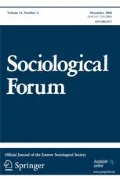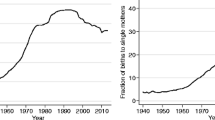Abstract
This study attempts to understand the role that housing plays in the system of social stratification. First, it generates a model of how housing outcomes are stratified along dimensions of socioeconomic status and race. Second, it asks what role housing conditions play in the system of educational stratification of offspring. Using two-generational data from the Panel Study of Income Dynamics, this paper demonstrates that home ownership is predicted by family income and race and that this indicator has a significant effect in predicting the educational attainment of offspring. Household crowding is also related to income and race and also affects the educational attainment of offspring. Meanwhile, housing quality—as measured by the physical condition of the unit—is not related to income or race and has no effect on educational attainment. Of particular note is that when socioeconomic status and housing conditions are held constant, African-Americans demonstrate more than a half-grade advantage over their non-black counterparts in years of completed schooling. In conclusion, the paper argues that housing matters not only for the immediate well-being of families, but also for the life-chances of the subsequent generation, and should be a standard variable in the conception of class background.
Similar content being viewed by others
REFERENCES
Altman, Irwin 1975 The Environment and Social Behavior. Monterey: Brooks/Cole.
Angel, Ronald, and Marta Tienda 1982 “Determinants of extended household structure: Cultural pattern or economic need?” American Journal of Sociology 87:1360–1383.
Blau, Peter, and Otis D. Duncan 1967 The American Occupational Structure. New York: Free Press.
Booth, Allan, S. Welch, and D. R. Johnson 1976 “Crowding and urban crime rates.” Urban Affairs Quarterly 11:291–308.
Brooks-Gunn, Jeanne, Greg J. Duncan, Pamela K. Klebanov, and Naomi Sealand 1993 “Do neighborhoods influence child and adolescent development?” American Journal of Sociology 99(2): 353–395.
Brooks-Gunn, Jeanne, Greg J. Duncan, and J. Lawrence Aber (eds.) 1997 Neighborhood Poverty: Context and Consequences for Children, Vol. I. New York: Russell Sage Foundation.
Caldwell, B. M., and R. H. Bradley 1984 Manual for the Home Observation for the Measurement of the Environment. Little Rock, AK: University of Arkansas Press.
Calhoun, J. B. 1962 “Population density and social pathology.” Scientific American 206:139–148.
Conley, Dalton 1999 Being Black, Living in the Red: Race, Wealth and Social Policy in America. Berkeley, CA: University of California Press.
Crane, Jonathan 1991 “The epidemic theory of ghettos and neighborhood effects on dropping out and teenage childbearing.” American Journal of Sociology 96:1226–1259.
Duncan, Greg J. 1976 Five Million Families: Results from Waves I-V of the Panel Study of Income Dynamics. Ann Arbor, MI: Institute for Social Research, University of Michigan.
Duncan, Greg J., and Daniel Hill 1989 “Assessing the quality of household panel survey data: The case of the Panel Study of Income Dynamics.” Journal of Business Economics and Statistics 7:441–451.
Edwards, John N. et al. 1994 Household Crowding and Its Consequences. Boulder, CO: Westview Press.
Edwards, John N., Theodore D. Fuller, Santhat Sermsri, and Sairudee Vorakitphokatorn 1992 “Household crowding and reproductive behavior.” Social Biology 39:212–230.
Edwards, John N., Theodore D. Fuller, Sairudee Vorakitphokatorn, and Santhat Sermsri 1993 “Household crowding and family relations in Bangkok.” Social Problems 40:410–430.
Featherman, David, and Robert M. Hauser 1978 Opportunity and Change. New York: Basic Books.
Foley, D. 1980 “The sociology of housing.” American Review of Sociology 6:457–478.
Fuller, Theodore D., John N. Edwards, Sairudee Vorakitphokatorn, and Santhat Sermsri 1996 “Chronic stress and psychological well-being: Evidence fromThailand on household crowding.” Social Science and Medicine 42:265–280.
Galle, Omer R., and W. Gove 1978a “Overcrowding, isolation and human behavior: Exploring the extremes in population distribution.” In K. Tauber and J. Sweet (eds.), Social Demography: 95–132. New York: Academic Press.
1978b “Crowding and behavior in Chicago, 1940–1970.” Residential Crowding and Design. New York: Plenum Press.
Gove, W. R., M. Hughes, and Omer R. Galle 1979“Overcrowding in the home: An empirical investigation of its possible pathological consequences.” American Sociological Review 44:59–80.
Hauser, Robert, and David Featherman 1976 “Equality of schooling: Trends and prospects.” Sociology of Education 49:99–120.
Haveman, Robert, and B. Wolfe 1994 Succeeding Generations: On the Effects of Investments in Children. New York: Russell Sage Foundation.
Hawkins, Homer 1976 “Urban housing and the Black family.” Phylon 37:73–84.
Henretta, J. C. 1979 “Racial differences in middle-class lifestyle: The role of home ownership.” Social Science Research 8:63–78.
Higgins, P. C., P. J. Richards, and J. H. Swan 1976 “Crowding and urban crime rates: Comment.” Urban Affairs Quarterly 11:309–316.
Hill, Martha S. 1992 The Panel Study of Income Dynamics: A User's Guide. Newburry Park, CA: Sage Publications.
Jackman, M. R., and R. W. Jackman 1980 “Racial inequalities in home ownership.” Social Forces 58:1221–1234.
Klerman, L. V., and M. Parker 1990 Alive and Well? A Review of Health Policies and Programs for Young Children. New York, NY: National Center for Children in Poverty.
Land, K. C., and S. T. Russell 1996 “Wealth accumulation across the life course: Stability and change in sociodemographic covariate structures of net worth data in the Survey of Income and Program Participation.” Social Science Research 25:423–462.
Leonard, P. C. Dolbeare, and E. Lazere 1989 A Place to Call Home: The Crisis in Housing for the Poor. Washington, DC: Center on Budget and Policy Priorities andLowIncome Housing Information Service.
Levy, F., and R. Michel 1991 The Economic Future of American Families.Washington, DC: The Urban Institute Press.
Liddell, Christine 1994 “South African children in the year before school: Towards a predictive model of everyday behaviour.” International Journal of Psychology 29:409–430.
Mahaffey, K. R., J. L. Annest, and J. Roberts 1982 “National estimates of blood lead levels: United States, 1976–1980: Association with selected demographic and socioeconomic factors.” New England Journal of Medicine 307(1):573-579.
Massey, D. S., and N. Denton 1993 American Apartheid: Segregation and the Making of the Underclass. Cambridge, MA: Harvard University Press.
McLanahan, S., and G. Sandefur 1994 Growing Up with a Single Parent: What Hurts, What Helps. Cambridge, MA: Harvard University Press.
National Center for Children in Poverty 1990 Five Million Children: A Statistical Portrait of America's Youngest Poor. New York: Columbia University School of Public Health.
Oliver, Melvin L., and Thomas S. Shapiro 1995 Black Wealth/White Wealth New York: Routledge.
Parcel, Toby L. 1982 “Wealth accumulation of black and white men: The case of housing equity.” Social Problems 30:199–211.
Quah, R., A. Stark, and J. W. Meigs 1982 “Children's blood levels in New Haven: A population based information demographic profile.” Environmental Health Perspectives 5:128–134.
Rosenbaum, Emily 1994 “The structural constraints on minority housing choices.” Social Forces 72(3):725–747.
1995 “Racial/ethnic differences in home ownership and housing quality, 1991.” Social Problems. 43:403–426.
Ruggles, Patricia 1990 Drawing the Line: Alternative Poverty Measures and Their Implications for Public Policy. Washington, DC: The Urban Institute Press.
Spilerman, S., N. Lewin-Epstein, and M. Semyonov 1993 “Wealth, intergenerational transfers and life chances.” In A. Sorensen and S. Spilerman(eds.), Social Theory and Social Policy: 165–186. New York: Praeger.
Stegman, Michael 1988 Housing and Vacancy Report: New York City, 1987. New York: New York City Department of Housing Preservation and Development.
Author information
Authors and Affiliations
Rights and permissions
About this article
Cite this article
Conley, D. A Room With a View or a Room of One's Own? Housing and Social Stratification. Sociological Forum 16, 263–280 (2001). https://doi.org/10.1023/A:1011052701810
Issue Date:
DOI: https://doi.org/10.1023/A:1011052701810



